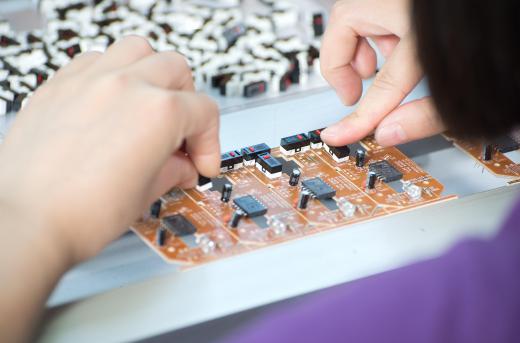The process of reflow soldering involves attaching components to metal pads on a circuit board with solder paste, and then subjecting the entire unit to heat. When uniform heat is applied to the components and circuit board, the temporary connections can become permanent solder bonds. Reflow soldering may be used with traditional through-hole technology, though it is the main method for connecting surface mount devices (SMDs). The purpose of the reflow soldering process is to submit the circuit board and components to a uniform level of heat that will melt the solder paste without damaging any of the electronics. Reflow soldering typically includes four distinct stages, each of which involves a different level of heat.
Traditional soldering typically involves through-hole technology, where component leads are passed through a circuit board and then heated individually as solder is applied. This type of soldering can be time consuming, and applying excessive heat to an individual component may be damaging. It is also difficult or impossible to use traditional methods with surface mount technology (SMT), where each component sits on top of the circuit board.

Solder paste is a compound that consists of flux and powdered solder. In addition to acting as an oxidizing agent, the flux in reflow soldering can also help bind an SMD in place until heat is applied. The paste is sometimes applied through traditional dispensing methods, though it is often stamped onto the board using a stencil to ensure proper placement. Problems with the initial application of solder paste may lead to device failures later on.
After the solder paste and components have been applied to a board, it is typically placed in a reflow oven and then subjected to four distinct temperature profiles. The reflow soldering process usually begins with an initial preheat, where the temperature will be raised between 1.0 and 3.0 degrees Celsius (about 1.8 to 5.4 degrees Fahrenheit) each second. This preheat is usually the longest of the four stages, and can be instrumental in allowing volatiles in the flux to evaporate while not damaging components through thermal shock. The second thermal stage is typically between one and two minutes long, and can allow the flux to remove any oxidation from the circuit board or components.
Solder reflow typically occurs during the third part of the heating and cooling process. This period may be known as time above liquidus (TAL), since the solder melts as the maximum temperature of the process is reached. At this point, the metal pads on the circuit board and the leads on each SMD will have achieved the same temperature, allowing strong solder bonds to form. After a set amount of time, the final cooling stage can begin. Allowing the components to cool in a well controlled manner can prevent thermal shock and ensure a successful reflow soldering process.
